Road Trip Around Ireland
The O'Learys' Irish Holiday and Ancestor Search - Part One
Introduction
This story is about the O’Leary’s road trip around Ireland in 2018 searching for ancestral links and clues. Adventures began and ended in Dublin with areas of historical significance and outstanding beauty coupled with moments of confusion and hilarity in between.
Part one of this story covers Dublin, Waterford, Carrick-on-Suir, New Ross and Cobh.
Planning the Road Trip Around Ireland
The main purpose of our road trip around Ireland in October 2018 was to see the birthplaces of our Irish ancestors and hopefully add more information to their stories. I thought three weeks would be enough time to drive around the island of Ireland explore our ancestral hotspots and also take in the natural beauty of the Irish landscape.
When I told a well-travelled cousin of mine that we planned a three week motoring holiday in Ireland he said, “you’ll be lucky to see anything.” Alarm bells rang as many google searches suggested two weeks would be enough time to drive around the island. He was joking. When he and his wife toured Ireland it rained every day and they viewed most of the main attractions through rain and cloud.
Another cousin who lives in England said: “Sue, I know you will love Ireland, it’s so pretty, but be warned, it really does rain a lot of the time!”
About Us
We are the O’Learys from Canberra, Australia. This was only our second overseas trip together, so let’s be clear, we are not that well travelled. Things frequently went wrong. For example we get lost a lot; we also lose things that are not really lost. Items like passports, glasses, travel cards and phones seem to go ‘missing’. We are prone to travel tantrums (him mainly) and for want of a better name, ‘he’, will from now on be referred to as ‘O’Grumpy’ in this story.
We also get confused; we don’t travel light (me), we don’t like crowds, we don’t like queues, we don’t like airports, we have a love/hate relationship with maps and ‘sat navs’. We are now 72 (him) and 66 (me). Next time we travel to Ireland or anywhere else in the world (if we ever go again) we want a guide and a Sherpa.
I thought three weeks would be ample time to drive our way around Ireland, but with hindsight another week or even two, would have been perfect. We are a lot slower than we used to be and we get weary after walking 8-10 ks a day. No late nights in Irish pubs for us.
This travelogue or story is based on diary notes I made during the trip.
Advance Bookings
On the advice of our travel agent we booked three things in advance – our flights, our first night (s) accommodation and our last night at an Airport hotel. This meant that we could fly into Dublin, get our bearings and enjoy a couple of days sightseeing before hiring the car and starting our journey. Booking our last night at an Airport hotel meant, in theory, that we could return our hire car without rushing, have a leisurely night and get the airport shuttle bus the following day. Remember ‘in theory’.
Accommodation on the Road Trip Around Ireland
I used Booking.com for accommodation as we travelled around usually staying a minimum of two nights at each place. This worked well most of the time. Some places were great, others looked better online than in reality. We hired a car (VW Golf) and paid extra for a TomTom an absolute necessity when it behaved. One thing we found very early in our trip was that signposting in both cities and regions isn’t one of Ireland’s strong points.
Travel Apparel
I took far too much. But then again I wanted to be prepared for anything. It was Autumn, my favourite time of year and the temperature averaged between 14-18 degrees Celsius so layers ruled. Yet looking back at our photographs I seem to be dressed in the same thing every day – jeans, short down jacket or mid length light down jacket with hood, leather walking boots and a fleecy cloche hat. Underneath a short sleeve or long sleeve T-shirt depending on the temperature.
O’Grumpy didn’t change much in our photographs either. He mainly wore his favourite comfy pants, a light fleecy top, a down vest or jacket, a cap or beanie and good walking shoes and he smiled every now and then. We also made sure we had a rain proof garment rather than just a shower proof one.
Travel Itinerary
In hindsight a bit more planning might have helped but we wanted to be as flexible as possible and let each day unfold. The places where we had ancestral links included:
Castlelost – Co. Westmeath (WALSH/SWEENEY – me)
Carrick-on-Suir – Co. Waterford or Co. Tipperary (O’LEARY – him)
Inchigeelagh – Co. Cork, the last remaining O’Leary Castle (O’LEARY – him)
Benburb – Co. Tyrone (HETHERTON/HARPER – me)
Eglish – Co. Armagh (KEARNEY/BURLEY of Co. Down – me)
As I was the chief planner, I decided we’d go in a clockwise direction starting with the O’Leary’s first in Carrick-on-Suir and then down, around and up to Northern Ireland where my family had links and then back to Dublin.
Unfortunately Castlelost became just that on our trip. This is where my GG Grandmother Mary WALSH lived. She and her sister Elizabeth (Eliza) emigrated to Australia as famine orphans, from the Mullingar Workhouse. They were 16 and 15 years old and they deserve my respectful attention, not rushed as it looked like being at the tail end of the trip.
I have written a story about the life of Mary and husband Henry Lindupp from the time they were married in Sydney, their life on the Victorian goldfields and then their pioneering life in Healesville. But Mary’s childhood in Ireland along with her sister’s is still a mystery. Eliza’s life in Australia is also a mystery. She seems to have disappeared into thin air after Mary married and left Sydney for Victoria.
These women are a good reason for a return trip to Ireland. In retrospect we should have gone to Westmeath from Dublin at the very beginning.
There’s More to Ireland than Meets the Eye
When you go to Ireland you soon realise you are not there to just take in the breathtaking scenery, you go to experience its history, a history that still talks. You can’t hear it but you can feel it. It’s palpable and it’s everywhere – the tragedies, the injustices, the struggles, the persecution, the violence and the victories. The Irish don’t let themselves or visitors forget the past. They know their history and if you have Irish ancestors it has a lasting impact. Furthermore if you have Irish ancestors you are made to feel that you are being welcomed back home.
Dublin
Arriving at Dublin Airport
O’Grumpy never took much interest in family history research until I obtained the death certificate of his G Grandfather, Edward O’LEARY. The record stated that he was born in Carrick-on-Suir (pronounced “Shure”), not Cork as we had initially believed.
When asked the purpose of our visit at Dublin Airport I was taken by surprise when O’Grumpy piped up first and proudly said: “We are looking for MY ancestors! MY G Grandfather was born in Carrick-on-‘Sewer’.” The friendly Customs officer said: “Ah, I think you mean Carrick-on-‘Shure’. Think of ‘Sea-Shore’”. She stamped our passports and said she hoped we enjoyed Ireland and then wished us luck. She probably thought we needed it.
Irish Taxis
The airport taxi queue was long but we were near the front. When our turn came we threw our bags into the boot with the help of the driver and piled in. As the driver pulled away from the kerb I had a terrible thought, what if he doesn’t take a card? I couldn’t see a machine. I asked nicely but his foot on the brake told me the answer before his tongue said, “NO”.
The taxi came to a grinding halt in the middle of the road and all eyes were on us as we piled out and did the walk of shame to the end of the queue. Eventually it was our turn again and this time the cab took card and the driver was friendly. This was a lesson to make sure we had cash and card in Ireland, including sterling cash in Northern Ireland.
Dublin City
We spent three nights in Dublin city. Two would have been plenty especially since our ancestors were agricultural labourers. However, you can’t go to Ireland without experiencing the city of Dublin.
Cassidy’s Hotel
Our travel agent booked us in at Cassidy’s on Cavendish Row, Upper O’Connell Street. This is fairly central and within walking distance of most attractions. It seemed to be the only accommodation available in Dublin City at the time we booked and it looked very charming online. Lovely staff, lovely food, clean and neat. But we needed a map and compass to find our room which was on the third floor. We were told at reception: “Just follow the signs to the Parnell Wing.”
Charles Stewart Parnell (1846-1891)
So on the first night we found ourselves heading to the wing named after famous rebel Charles Stewart Parnell, the great Irish nationalist hero who led the struggle for Irish home rule and land reform in the late 19th century. Sadly an adulterous affair with a supporter’s wife ruined the handsome Parnell’s political career in 1889 and he died soon after in 1891.
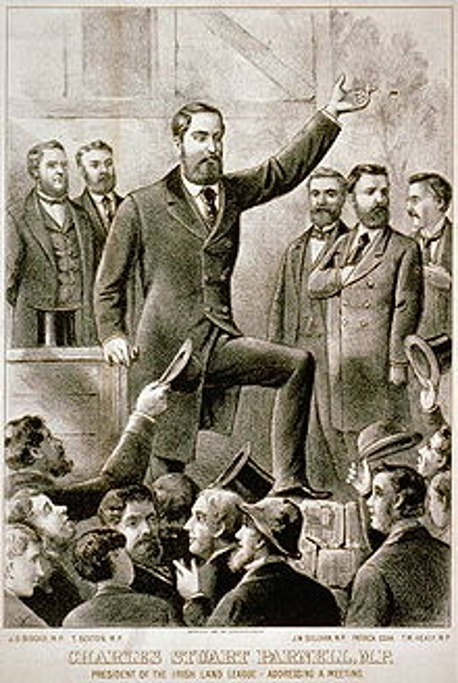
Confusion in the Corridors of Cassidy’s
As instructed we headed off along the corridor looking for the Parnell Wing sign. It felt like a 100-metre straight, but it was probably less, and at the end there was a sign to the Parnell Wing with an arrow pointing right. But the corridor took a quick left and there was another long walk. We reached a dead end and no Parnell Wing sign except there was a lift to our right and descending stairs to our left. We should have seen the stairs as a clue and not been so surprised when the only way the lift went was DOWN even though we needed to go UP to the third floor. O’Grumpy thought it was some sort of Irish joke. We were confused but we didn’t think we’d find our way back to Reception to check.
For all we knew this lift was the Tardis. It was not much bigger than a phone box and we just managed to fit in with our luggage. The lift took us down and we were relieved to see a Parnell Wing sign when the doors opened. This corridor also had a surprising feature, it seemed to go uphill for about 25 metres and then down. It ended at another lift which actually took us up to the third floor. After more twists and turns we found our room. I said to O’Grumpy: “What if there’s a fire we won’t find our way out?” He replied: “I’d be more worried if there was a flood. We’d need the Thai cave rescue divers to get us out.”
We found our way back to reception and to the cosy dining room that night by retracing our steps. A ball of string would have helped. There was an excellent selection of appealing dishes on the set dinner menu and it seemed good value. Our meals were delicious. The only confusion came when ‘O’Grumpy’ asked for a non-alcoholic beer and he was asked if he wanted ice. The waiter was confused with the request for non-alcoholic beer and ‘O’Grumpy’ was confused with “do you want ice?” Importantly we got back to our room without getting lost.
Problem Solved
Before we could do any sightseeing the next day ‘O’Grumpy’ decided that for safety reasons it was necessary to do a complete exploration and geographical survey of the hotel to work out where our room was and why the need to go down before going up.
It took a while to figure it out but the explanation was that our room was on the third floor of another building across a road. This explained why it was necessary to take the lift down from the ground floor in the main building so we could walk under the road to get to the other side and then take another lift up. Simple.
By the third day in the hotel we walked around with smug looks when we saw new arrivals wandering around with puzzled looks, because by that time we knew where we were going. We ate in the Hotel Bistro for the three nights as the food was extremely good and we didn’t feel the need to experience Dublin night life; we could hear bits of it anyway.
Sightseeing in Dublin
Luckily it didn’t rain while we were in Dublin, so no flooding in Cassidy’s, but just to be prepared I went to Dunnes in Henry Street and bought a genuine raincoat. There were racks of them and I was spoiled for choice. When it rained I was going to be ready. We also bought two feather pillows, two pillow slips and two cups. Did I mention we were fussy?
The Book of Kells was on the top of my sightseeing list in Dublin and a brisk walk from Cassidy’s. On our way we were stopped by a man dressed as a pastie advertising a bakery and for a split second I thought it was Dermot, one of ‘Mrs Brown’s Boys’.
Eventually we found our way to Trinity College saw the Book of Kells and soaked up the knowledge and wisdom oozing in The Long Room with many other people. The main chamber or the Long Room of the Trinity College Library is 65 metres in length and houses 200,000 of the Library’s oldest books. Marble busts of great Western philosophers and writers line both sides of the chamber including Plato, Socrates, Isaac Newton, John Milton, Edmund Burke and Jonathan Swift author of Gulliver’s Travels.
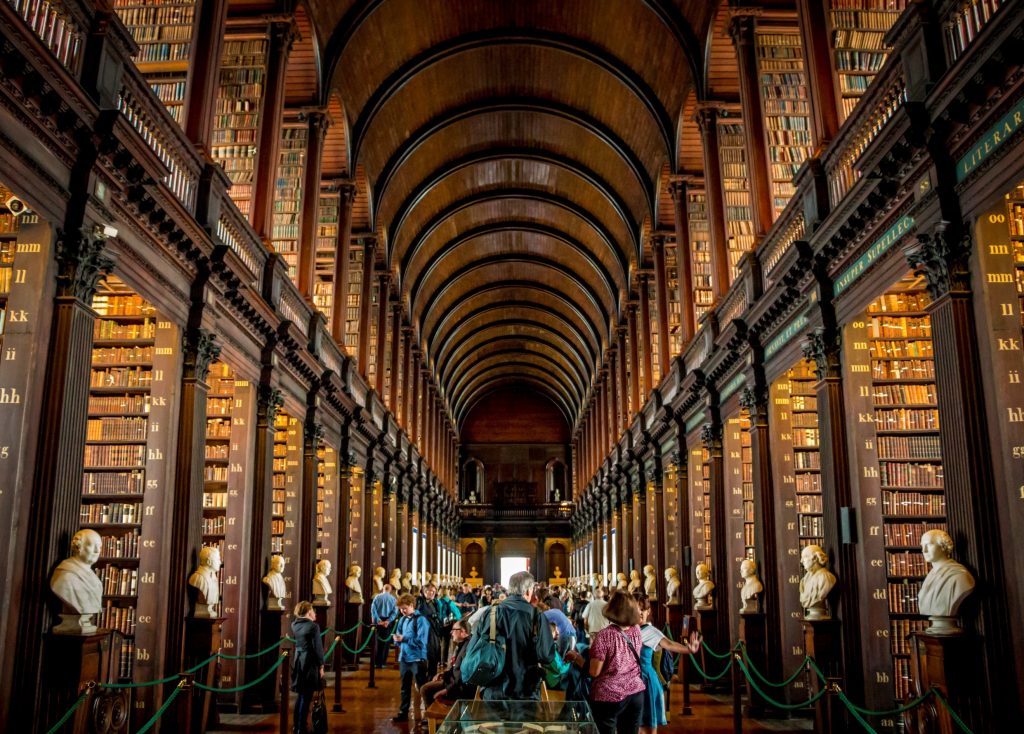
Dublin is geared for tourists with an Irish knitwear shop in just about every street even the Trinity College gift shop had woollen garments for sale. I wanted to buy everything I saw – shawls, hats, caps, gloves, snoods, jumpers, scarves probably because I wanted to look like the Irish country girl wrapped in Irish wool on the advertising posters. No chance of that but I loved it all and ended up buying a jumper at The Sweater Shop opposite Trinity College which I will probably never wear because it will never be cold enough to wear in Australia, even in winter.
We loved walking the streets of Dublin with the monuments to Irish Republican heroes in the O’Connell street thoroughfare, the famous GPO which became the headquarters for the Irish rebels in the 1916 Easter Rising, and the James Joyce statue which goes by another name according to a school boy (an English school boy). But when I saw an open-air bus of young tourists wearing Viking hats on the Viking City Splash tour that’s where I most wanted to be. Next time perhaps.
If we needed our bearings we just looked for The Spire or the Monument of Light, a 120 metre stainless steel spike in O’Connell street near the GPO and walked in that direction. The Spire replaced Nelson’s Pillar which was blown up by the IRA in 1966.
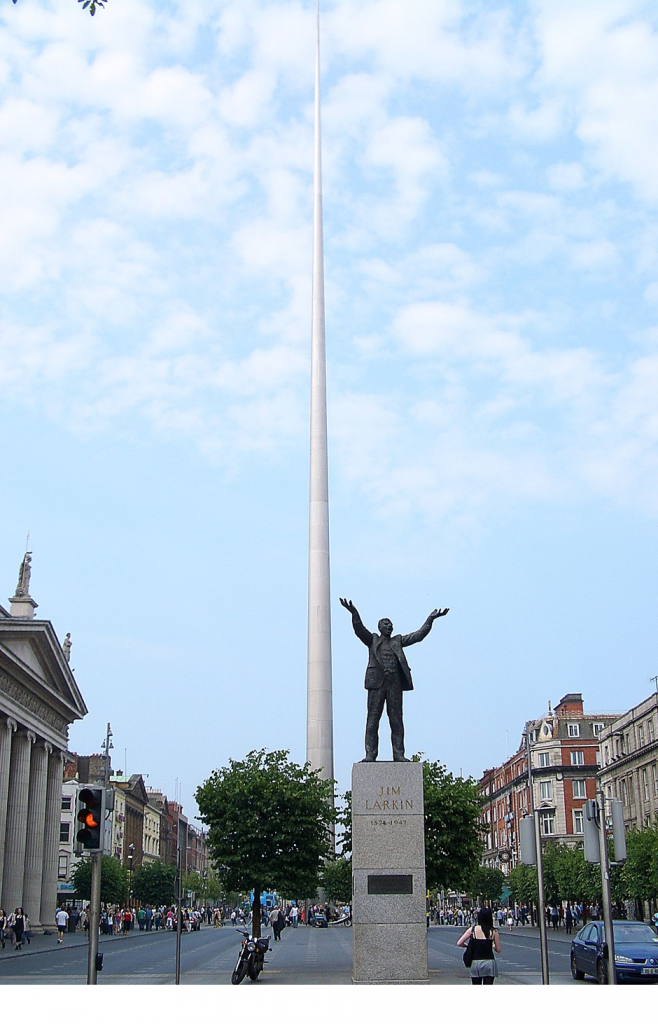
The Road Trip Around Ireland Begins
After three nights and two days we farewelled Cassidy’s and Dublin. The hire car was ready for us to pick up on the edge of town and after haggling about the insurance, which ended up being more expensive than the car, we hit the road to Waterford around 170 kms from Dublin, a convenient and central place to stay for our explorations in Carrick-on-Suir.
Waterford
It was an easy drive out of Dublin onto the M5 and then an easy drive to Waterford. However it wasn’t as easy finding our accommodation at Milepost Village which was over the main bridge and about 2.5 kilometres from Waterford’s city centre. ‘TomTom’ was determined to take us up a private farm lane which earned us a few stares from the resident family.
Diamond Hill Country House
After several re-routeings and phone calls we found Diamond Hill Country House where we were greeted by the friendly manager, Liz, who insisted on helping us unload the car and carry our bags to our upstairs room. I bet she wished she hadn’t when she saw the bags and the pillows.
Our room was large with a lovely view to the front garden and the bed was comfortable. There were towels and hand towels in the bathroom but no face washers. I found this frustrating, because I do love a face washer but it seemed to be standard practice in Ireland. O’Grumpy also had a problem with the shower over the bath but it wasn’t a problem for Liz who showed him where he could shower in safety.
Diamond Hill is in a beautiful country setting and heading down to breakfast the next morning we couldn’t help but notice four lazy cows roaming behind the guest house looking like they might explode because of the lush feed. We thought we might explode as there was no escaping a full Irish breakfast at Diamond Hill – eggs, bacon, sausages, black pudding, tomatoes, red or brown sauce, toast, Irish soda bread. Cooked by Liz. We soon realised Liz did everything. She was super woman.
Dining in Waterford
On the subject of food we found two excellent restaurants in Waterford. Dinner at Dooley’s Hotel was a reasonable €19 for the early bird two course menu. The food was delicious. But be warned get there early before any tour group descends on the dining room.
Our second dinner was at La Fontana, an Italian restaurant on the main promenade where we were treated to the most delicious Tomato and Basil soup as an entree. Once again we took the early bird option and at €20 per head the price was very reasonable, even with drinks added on. Parking was also easy in Waterford.
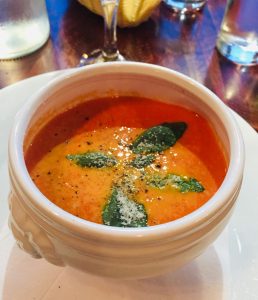
You Can’t Escape Mashed Potato
Another warning, mashed potato accompanies just about every dish in Ireland and be prepared for generous servings. So if you love potato, Ireland is Heaven. You will never leave a restaurant hungry or unsatisfied. I’m sure this a Great Famine legacy.
Sightseeing in Waterford
There’s so much to see and learn in Waterford. Our favourites were learning about Thomas Francis Meagher (who even earns a place in the Australian Dictionary of Biography) and of course the Vikings.
Thomas Francis Meagher’s (1823-1867) Story
You can’t help but be inspired by Waterford’s own Thomas Francis Meagher, the swashbuckling Irish nationalist who had little patience with long drawn out peaceful approaches to Irish independence. He came from one of the few wealthy Catholic families in Waterford; was well educated, intelligent, a great speaker and passionate about Irish nationalism.
The tragic consequences of the potato famine on the Irish people appalled Meagher and he largely blamed Britain, who continued to receive food exports from Ireland, for the catastrophe.
He joined other young fiery rebels in the Young Ireland movement and travelled to France to learn from the French revolutionary movement. He returned with the original tricolour flag of Ireland handmade and given to him by female French sympathisers.
The Flag was unveiled and flown for the first time in Ireland from the Wolfe Tone Club, 33 The Mall, Waterford City in March 1848. It flew proudly for eight days before it was removed by British Forces.
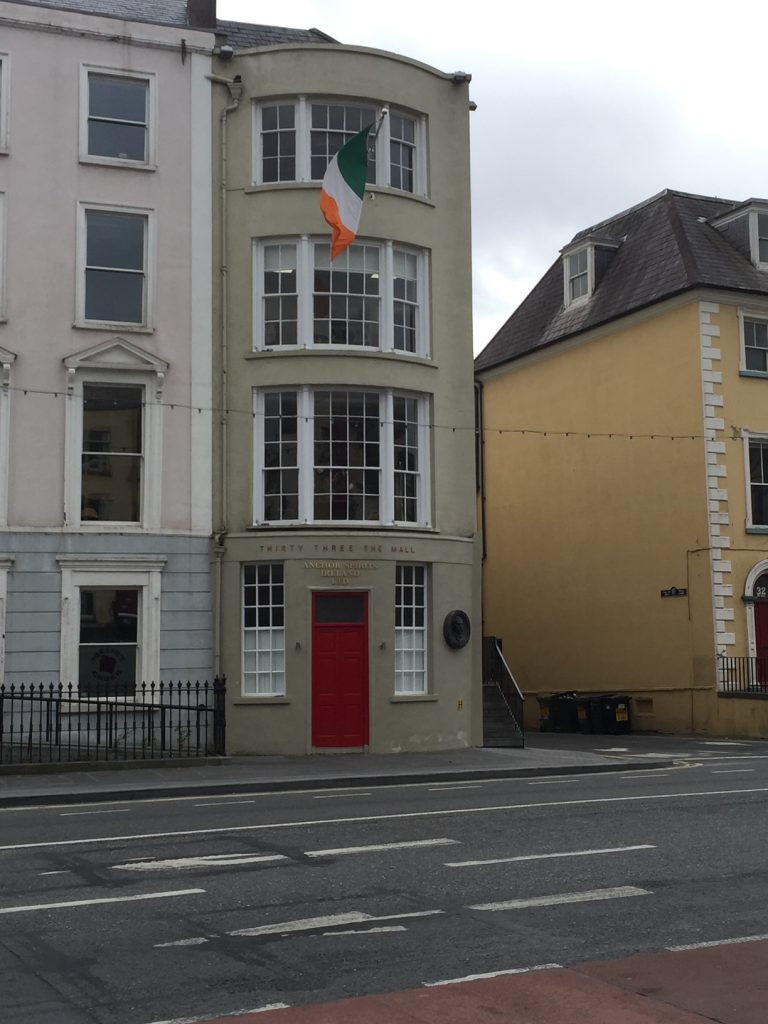
On presenting the flag to the people of Dublin a month later in April 1848, Meagher said:
“The white in the centre signifies a lasting truce between the ‘Orange’ and the ‘Green’, and I trust that beneath its folds the hands of the Irish Protestant and the Irish Catholic may be clasped in generous and heroic brotherhood.”[i]
Later in that year Meagher took part in an uprising in Co.Tipperary known as the ‘Battle of Widow McCormack’s Cabbage Patch’[ii] for which he was arrested with his fellow rebels, charged with sedition and sentenced to be ‘hung, drawn and quartered’.
The public outrage forced Queen Victoria to commute his sentence to transportation for life to Van Diemen’s Land (now Tasmania) in Australia. Three years into the sentence Meagher escaped by taking a boat and rowing into Bass Strait. Luckily he was rescued by a passing American whaling ship which took him to San Francisco and from there he moved to New York. What was he thinking rowing himself into Bass Strait? It’s not as if Bass Strait is the River Liffey. Today it takes the Spirit of Tasmania – a roll-on roll-off ferry – about 9 hours to sail from Port Melbourne to Devonport, Tasmania.
Nothing could stop this adventurer and activist. In America he continued his legal studies and became a lawyer, a noted orator, a writer and he also established newspapers aimed at the growing Irish population in America. He never stopped believing in an Ireland free from British rule and drew inspiration from the American War of Independence.
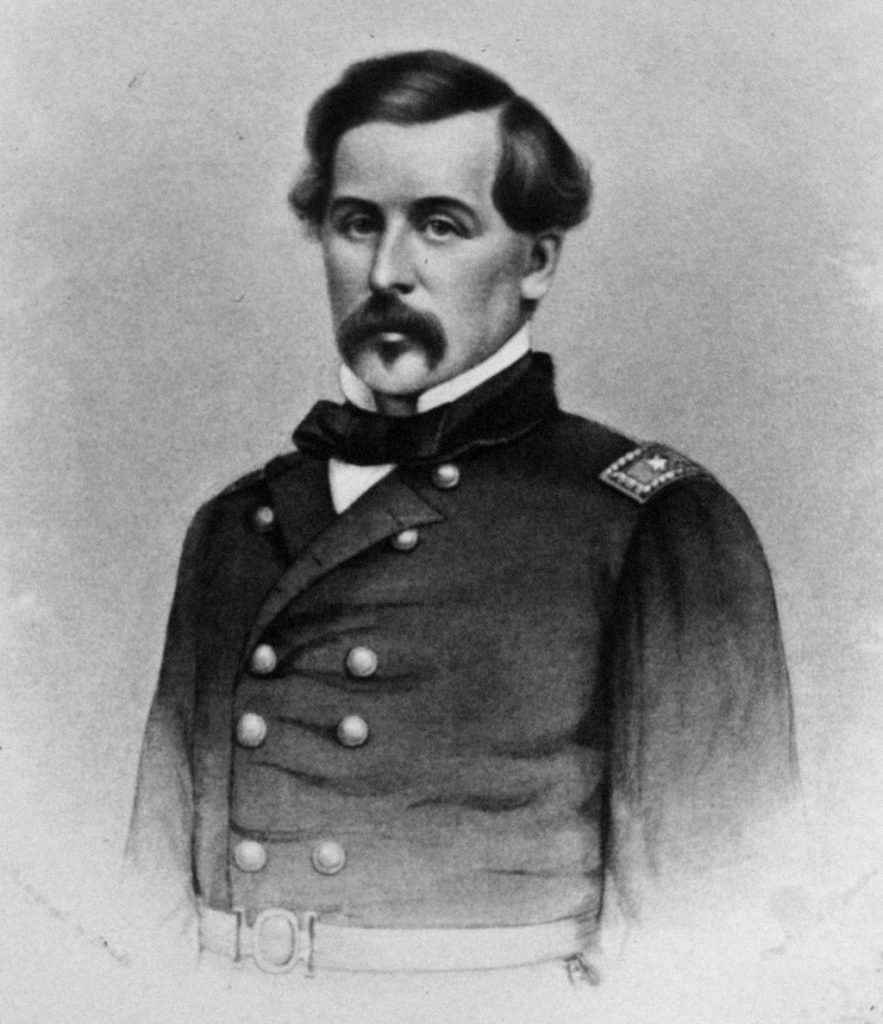
In 1861 Meagher witnessed the beginning of the American Civil War and ended up fighting with the Union army where he recruited “healthy, intelligent and active young Irishmen” who became the Irish Brigade or the “fighting 69th” . He soon rose to the rank of general and commanded soldiers who wore sprigs of clover in their hats and marched under a green flag bearing the words “Erin go Bragh” or “Ireland forever” and an embroided harp, the official emblem of Ireland.
The Irish Brigade were fierce fighters but suffered heavy losses at the Battle of Antietam – 540 men in total – and Meagher himself was injured when he fell off his horse.
At this point the story about Thomas Francis Meagher gets a bit murky. Some reports say his horse was shot from underneath him.[iii] Some reports say he was drunk when he went into battle.[iv] The official report said his horse was shot.[v]
After the Civil War President Andrew Johnson made Meagher the Territorial Secretary of Montana and he served as Acting Governor until he died on 1 July 1867 aged 43 years. He drowned in the Missouri River after he fell from a steamboat at Fort Benton. The circumstances of his death remain a mystery and the subject of dispute by historians. Some believe he fell because he was drunk, others because he was weakened by dysentery, others think he committed suicide and others that he was murdered by Montana political opponents.[vi] His body was never found.
Andrew Doherty in his ‘Waterford Harbour Tides and Tales’ blog says:
“T.F. Meagher is a man who despite having four family graves around the world is found in none of them.”
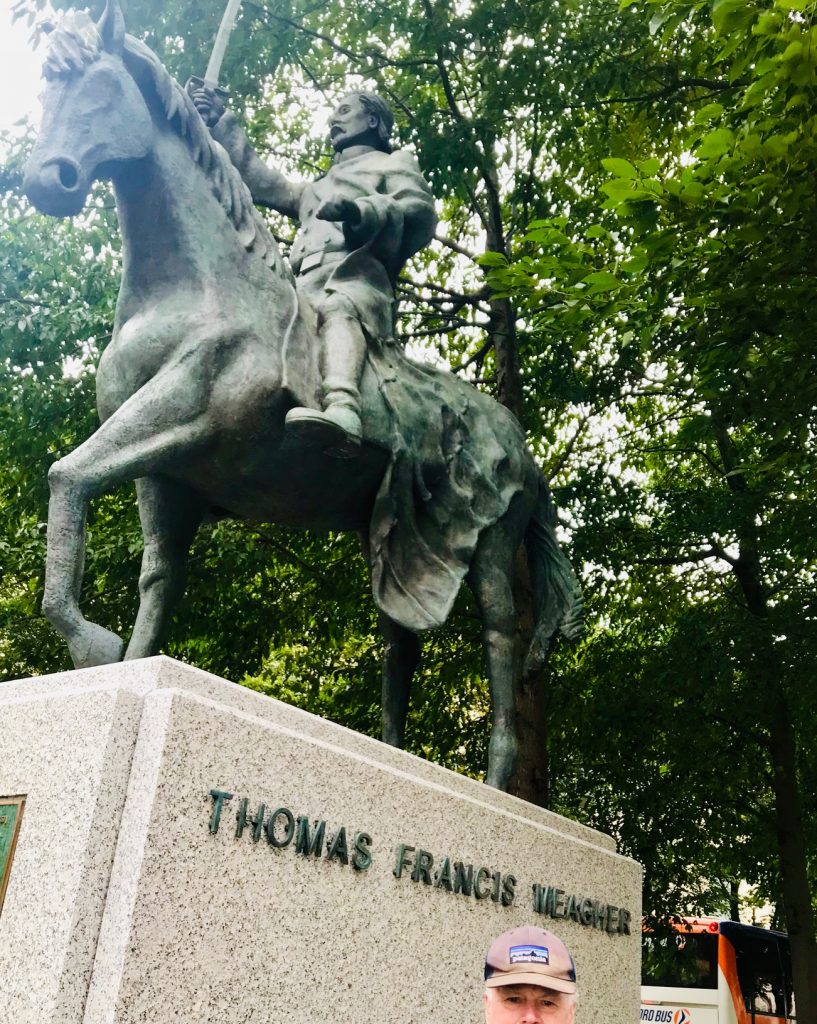
O’Grumpy sent a photo of the statue of Thomas Francis Meagher in Waterford to his golfing mate Thomas Francis Meagher in Canberra and asked if they were related. The answer was: “No. But my father named me after him.” What an honour. Named after your father’s hero. It shows that the extraordinary and heroic deeds of Thomas Francis Meagher continued to inspire generations long after his death.
Vikings in Waterford
Waterford said to be the oldest city in Ireland is Viking Central. Vikings established Waterford city around 914 AD but recent archaeological excavations suggest there was a Viking settlement nine kilometres away in Woodstown predating the Waterford settlement by 50 years.[vii] Nevertheless there are enough Viking attractions in Waterford to keep any Viking enthusiast happy.
There are still remnants of the ancient walled city core including Reginald’s Tower, the oldest civic building in Ireland and where Waterford’s Viking Treasures are housed. Reginald’s Tower is an Anglo/Norman structure built around 700 years ago on the site of the original Viking fortress and is probably named after the last Viking ruler Ragnall Mac Gill Muire. You can see why the building was used as a mint in 1463, a munitions depot in the 17th and 18th centuries and a prison in the 19th century, the building is impenetrable. Even a cannonball fired by Cromwell’s army in 1649 did not penetrate the structure as it can still be seen stuck high in the north side wall .

If you wish to be an armchair tourist in the days of Coronavirus you can take a virtual tour of Reginald’s Tower housing the Viking treasures (http://www.waterfordtreasures.com/reginalds-tower/the-experience/virtual-tour) as you can with the other two museums in the ‘Viking Triangle’; the Mediaeval Museum housing treasures from the Middle Ages (http://www.waterfordtreasures.com/bishops-palace/the-experience/virtual-tours) and the Bishop’s Palace showing treasures from the 18th, 19th and 20th centuries (http://www.waterfordtreasures.com/bishops-palace/the-experience/virtual-tours). Each museum is beautifully curated.
A delightful young Irish woman, an interior designer staying at Diamond Hill, told us over breakfast that the Vikings were the first town planners, something I had never realised, but soon realised when I saw the Waterford township model and layout in Reginald’s Tower.
She also confessed to us that she didn’t see anything of Canberra on her one and only Australian holiday as she thought ‘jet lag’ was a state of mind and didn’t factor it in to her travel plans. Instead of catching up, partying and sightseeing with her friends in Canberra, she found herself wiped out in a hotel room for the first two days of her holiday.
Carrick-on-Suir
Where our Ancestor Search Begins
Historically Carrick-on-Suir was a busy river port and important commercial hub with a thriving river trade. There was general prosperity when the 1799 census of Carrick-on-Suir was undertaken of the largely Roman Catholic population. The woollen industry was significant and other businesses that were mainly river related such as fishing and basket weaving provided employment. In its heyday, the mid to late 17th and early 18th centuries – the population was nearly 11,000.
However, high British taxes and levies on the woollen industry threw the town into an economic crisis with high unemployment and poverty. There was widespread “deprivation, hunger, illness and disease resulting in multiple deaths.” It was an early famine and it caused an exodus of people from the area. The population never recovered and today sits at around 6,000.
Carrick-on-Suir was a 30 minute, drive from Waterford and we found our way without getting lost. When we arrived there was hardly a soul to be seen in the pretty township. We parked the car near the Heritage Centre, housed in the old Protestant Church but unfortunately it was closed.
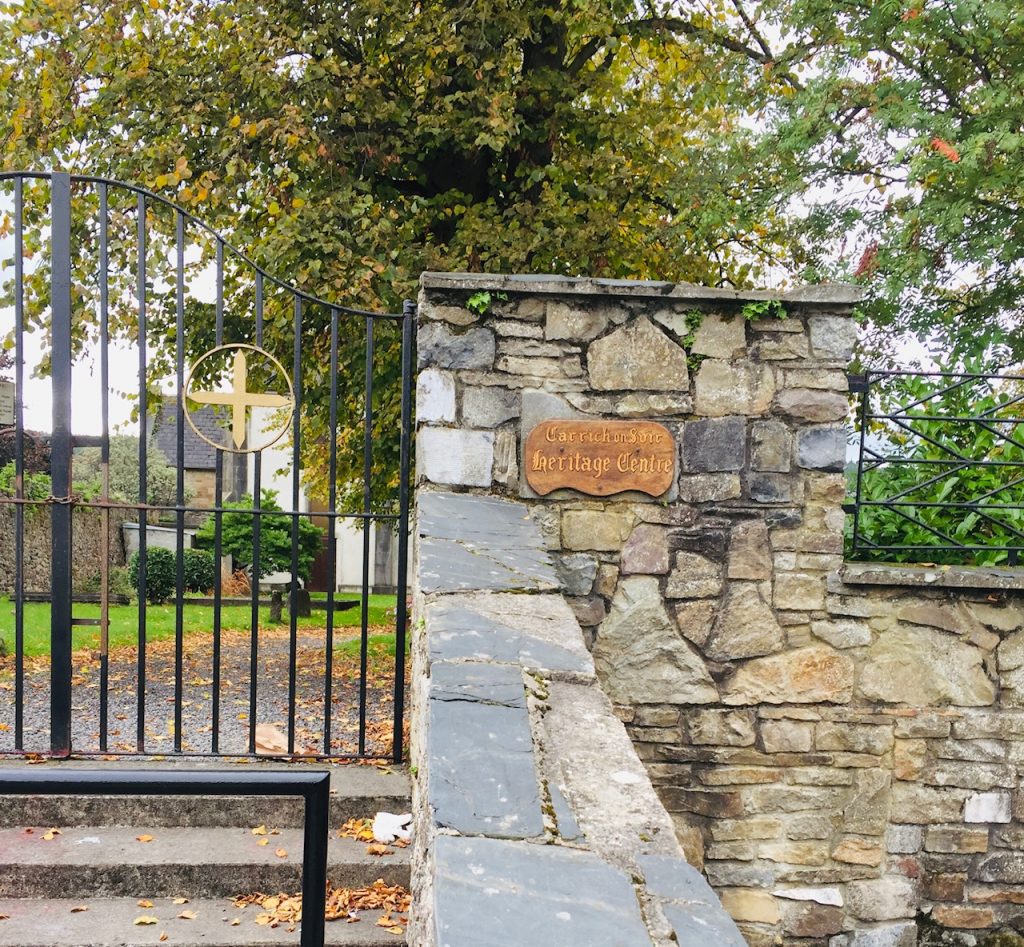
It was Sunday.
The Heritage Centre was not the only place closed everything was. Unlike Australia where everything is open on Sundays, the Sabbath in Ireland is still respected.
We found one tiny café open in defiance so in we went for tea and fruit scones (as you do after a full Irish breakfast) and asked if the Heritage Centre would open later in the day. “No, it was closed all day Sunday,” but, the waitress added: “The man who runs the Centre was probably walking around the town and if we bumped into him, he would probably talk to us because he was very friendly. He has grey hair and glasses.” Well that narrowed things down! No sooner had she spoken than a man with grey hair and glasses walked past the café and I asked if it was the Heritage Centre Man. “No, that’s not him.”
We decided to return the next day when the Centre was open but in the meantime we walked around the town discovering that yes, most of the town was at Mass. It was standing room only at St Mollerans Catholic Church, a church built on the site of a 13th century friary.
A beautiful stone wall built by paupers in a work-for-food project during the potato famine is the front wall to the church and a plaque there reminds you of the dreadful calamity. The words say:
“This wall was built in 1846. The year memorable by the failure of the potatoe (sic) crop and consequent scarcity of food.”
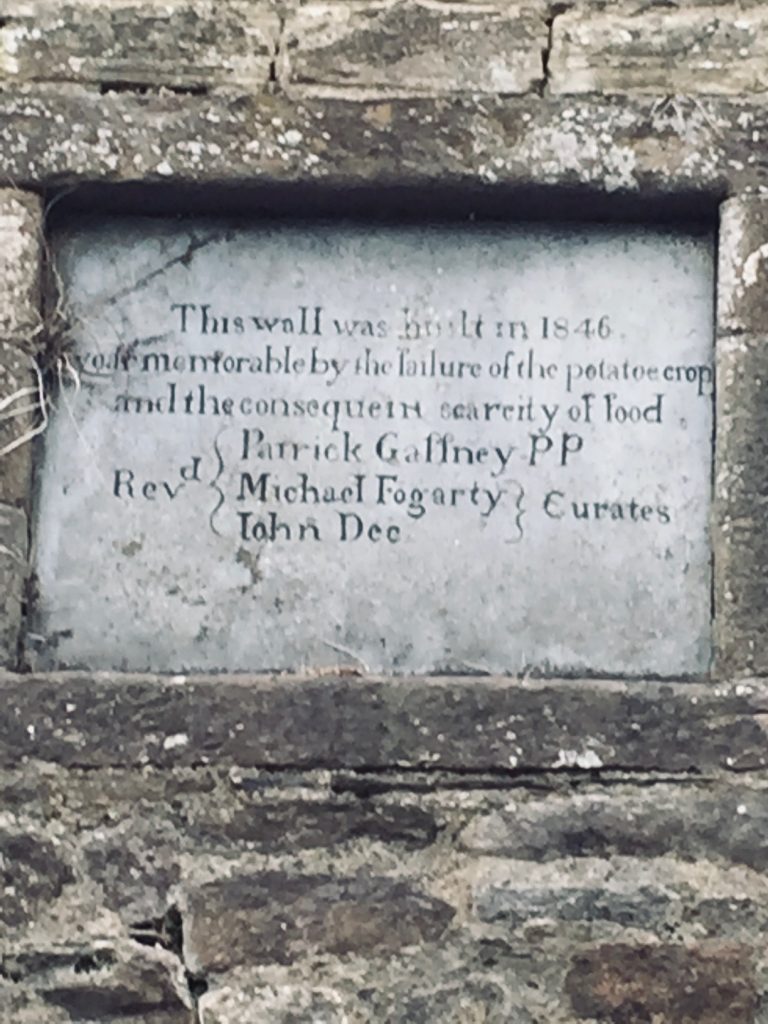
There’s nothing like a graveyard walk for family historians so we walked up and down rows in the two cemeteries associated with the Church checking unsuccessfully for O’Leary headstones.
However, we did discover that Edmund Rice, founder of the Christian Brothers, started his ministries in Carrick-on-Suir after the death of his wife and birth of a handicapped daughter.
The Old Bridge at Carrick-on-Suir
The Old Bridge with its beautiful arched pillars (or piers) was built in 1447 and made Carrick-on-Suir a place of strategic and economic importance linking Co. Waterford and Co.Tipperary. It was a great facilitator of trade particularly between South and East. Waterford city, which sits downstream from Carrick-on-Suir did not get a bridge until the 1790’s.
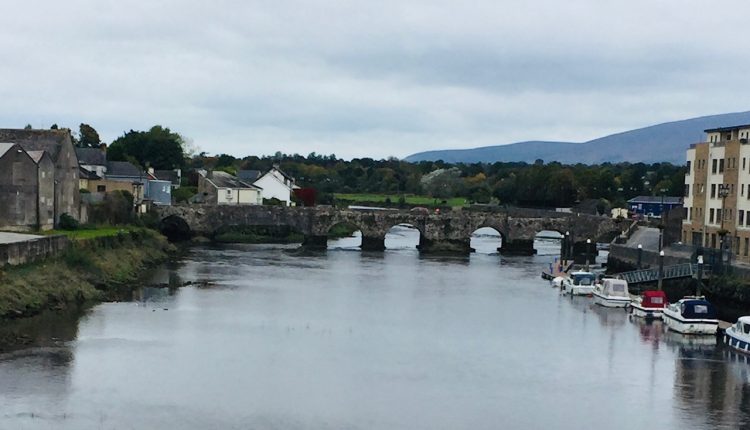
The Old Bridge was particularly important in Cromwell’s South Eastern campaign because the bridge linked South Leinster to East Munster and holding the bridge was a military must. Cromwell eventually took Carrick-on-Suir in November 1649 despite the town being heavily defended by Irish forces.
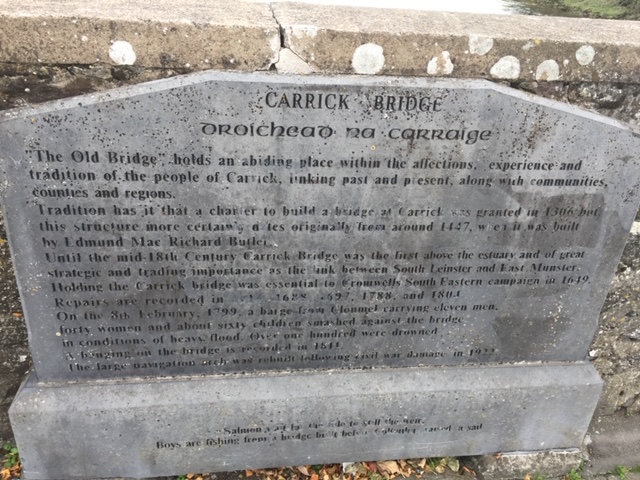
The Old Bridge was not without tragedy. On 8 February 1799, a barge carrying 111 passengers – 11 men, 40 women and 60 children – crashed into the bridge during a heavy flood. Over one hundred people drowned in that terrible incident.
The plaque pictured above also mentions that a hanging took place on the bridge in 1811. I was told that four males were hung from the bridge charged with ‘Whiteboy’ activity which was common in the rural counties of Tipperary and Waterford. ‘Whiteboys’, the original Irish rebels who formed in 1761, fought for tenant farmers rights and were known for their night raids dressed in white smocks.
Carrick-on-Suir Heritage Centre
When we returned to the Heritage Centre on Monday it was open and manned by a delightful husband and wife team. The man wasn’t entirely grey, and he didn’t wear glasses. I had information from the 1799 Census of Carrick-on-Suir[viii] which did record an O’LEARY family: Arthur (Basket Maker 34), Grace (32), Patrick (7), Mary (3) and Bridget (0). Johana (67) also lived at the same address on Greenside South and was probably Patrick’s mother. There was also a LEARY family: Henry (Labourer 55), Margaret (33), Patrick (10) and Mary (13). They lived on Bally Richard Road West and a Mary Leary (78) and another Mary Leary (36) lived on Old Shambles Lane and McCanns Lane respectively.
The couple were well versed in the area’s history and the old family names associated with Carrick-on-Suir but there were no O’Learys in their memories or records. They explained that the area went through very tough times around the time Edward O’LEARY was born in 1841 which was before the famine and many families left for the bigger towns to find work. They thought the O’Leary’s probably headed to Cork which was our next destination.
On our way to Cork, they suggested we visit the Heritage Centre at Cobh (pronounced ‘Cove’), as most Irish emigrants left their homeland from this port and we might be lucky to find a record of Edward O’LEARY there. They were very generous with their time and gave us a beautiful booklet about the history of Carrick-on-Suir.
Ormond Castle and Thomas ‘Black Tom’ Butler
In the meantime we made the most of our time in Carrick-on-Suir and visited Ormond Castle located on the outskirts of Carrick-on-Suir. A guided tour was recommended and we enjoyed the experience with Seamus who told us the story of Ormond Castle’s owner, Thomas Butler 10th Earl of Ormond, 3rd Earl of Ossory and Viscount Thurles (c 1531-1614) otherwise known as ‘Black Tom’.
Most of the renovations done to the Castle were done in anticipation of his cousin, Elizabeth I visiting. The decorative plasterwork is exceptional and lauded as one of the finest examples in Ireland.
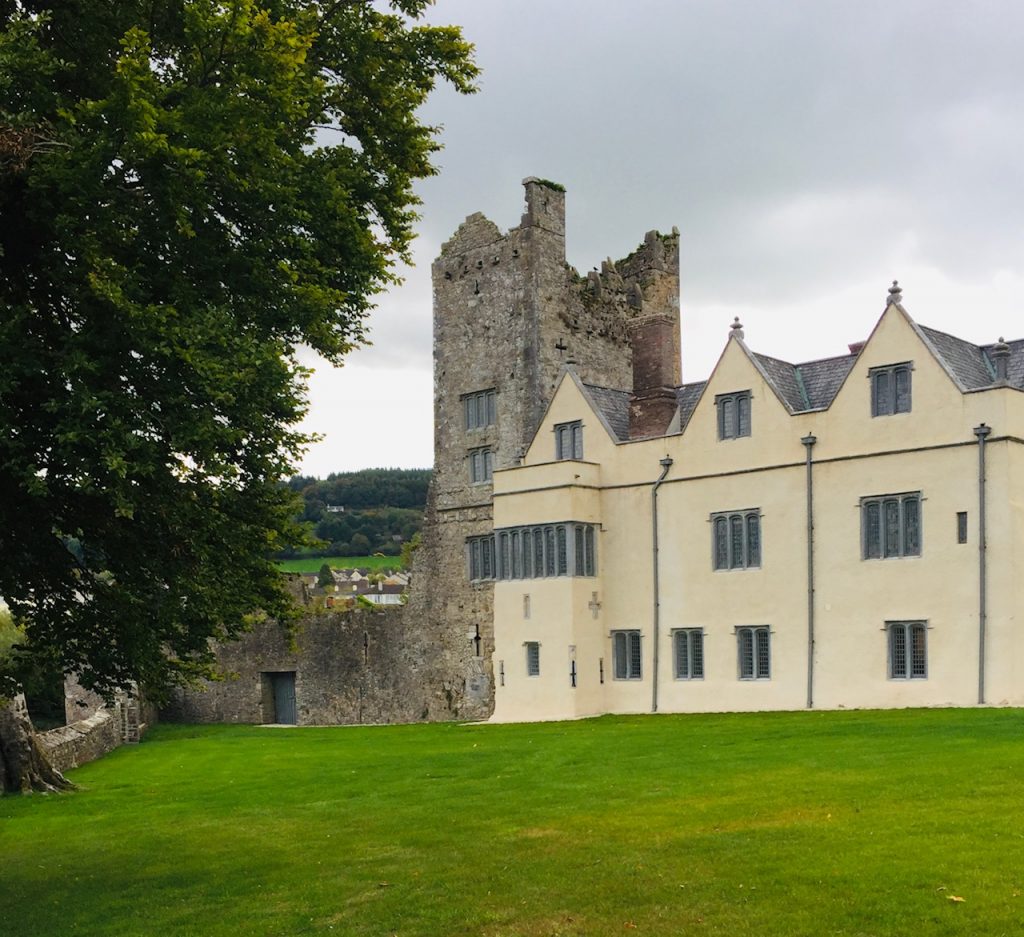
We were told that not only was Elizabeth I Black Tom’s cousin, it was rumoured that she was also his lover. Sadly for ‘Tom’ she never visited Ormond Castle as a cousin or a lover. And ‘Black Tom’ although born a Protestant Irishman, died a Catholic.
New Ross
The Dunbrody Famine Ship Experience – A Living Museum
I wanted to see a Barque sailing ship and see how steerage passengers like my ancestors were accommodated. I’d seen sketches in books and read about the conditions, but I really wanted to see a ship and get a feel for the conditions myself.
When I told Gerry, the ever helpful host at Diamond Hill, he drew up an itinerary for a day at New Ross where there’s a full-sized replica of the Dunbrody Famine Ship that you can board and explore as part of regular tours. The famine ships heading to America had another name – ‘Coffin Ships’ – steerage passengers especially, were lucky to reach America alive. In most cases you could smell the ships before they entered New York Harbour. Conditions were appalling.
JFK
As part of this living museum there is a stirring Human Migration Monument with an eternal flame lit from the eternal flame at JFK’s grave in Arlington. New Ross is the place where Patrick Kennedy, JFK’s G Grandfather left for Boston in 1849. Although the centre focuses on American migration the monument memorialises and pays tribute to all the Irish people forced to migrate to America, Canada, Australia and the UK due to the famine in search of a better life.
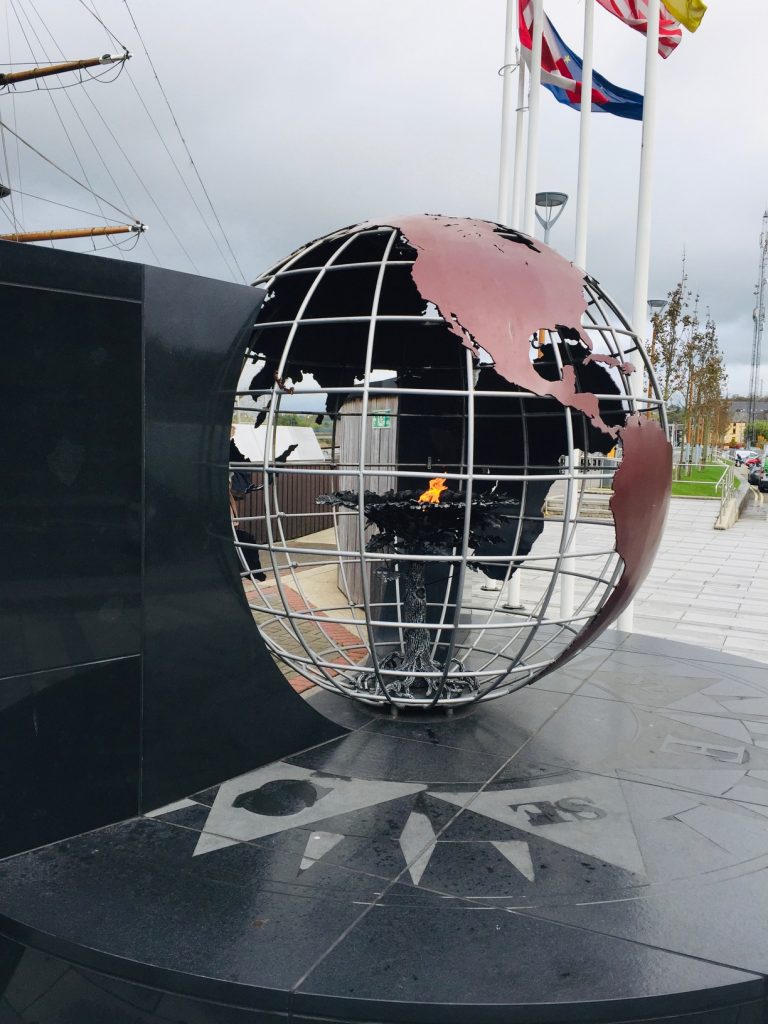
You get to see and feel the pain of Irish history when you take this extraordinary Dunbrody tour conducted mainly by young people who reenact the passengers’ ordeals. It is an emotional and passionate portrayal of the Irish emigration story and the events behind it. The museum curators have researched most of the passengers on the Dunbrody and tell harrowing tales of how some passengers met their fate. Scenarios are acted out by professional actors. The experience stays with you.
After the tour we headed to the café above the wharf for our daily dose of tea and scones which never failed to satisfy. Tea was much better than coffee in Ireland and ‘Barry’s’ tea with its beautifully rounded flavour was something to look forward to. We sat next to an old Irishman who was by himself sipping tea and eating bread and butter. He must have been a regular in this tourist café and he was a dear old soul. He gave me his Irish Times and although I couldn’t understand a lot of what he was saying I did manage to hear about his aneurysm and hernia.
Cobh
Cobh Heritage Centre
We said good-bye to Diamond Hill and thanks to our friends at the Carrick-on-Suir Heritage Centre we headed to Cobh (formerly Queenstown) on our way to Cork. Cobh, is a picturesque port town and significant for family historians because it’s the place where most Irish emigrants took their last steps on Irish soil. It was also the last port of call for the Titanic before it sunk.
The Centre houses informative and emotive exhibitions. You can check emigration records, but in reality, you can do that online searching at home. I thought there might have been different records to search, but the data was the same data I could access on my computer in Australia. So I still couldn’t find a result for Edward O’Leary telling us when he left for Australia and on what ship.
The resident genealogist who happened to be selling tickets into the exhibition seemed to love a chat and I told him we were on an ancestor hunt for the family of Edward O’Leary to which he replied: “Most of the O’Learys were in West Cork along with the Sullivans”. That was interesting information because O’Grumpy’s G Grandfather married a Catherine Sullivan in 1866 in Auburn, the Clare Valley, South Australia.
Our tickets came with the name of a passenger aboard the Titanic whose destiny we were to trace despite knowing it wouldn’t end well. I didn’t think my destiny would end well when I offered to move our car from the city centre to the Heritage Centre car park to take advantage of another two hours free parking.
This would be the first time for me in the driver’s seat and I only offered because the car was about 500 metres away and I can walk much faster than O’Grumpy. While very used to manual cars I had never driven a car that had an electronic handbrake. The car was parked nose to kerb and with the handbrake released and in reverse I released the clutch gently as I pressed my foot on the accelerator. The car moved forward. I tried again. The car moved forward. If only I could do a handbrake reverse start with a real handbrake. I tried one more time and again the car moved forward. The nose was now about one millimetre from touching the stone wall in front. I was thinking insurance, insurance, insurance. I decided to quit while I was ahead, went back to the Heritage Centre and confessed to O’Grumpy that we could potentially have an insurance issue with Hertz.
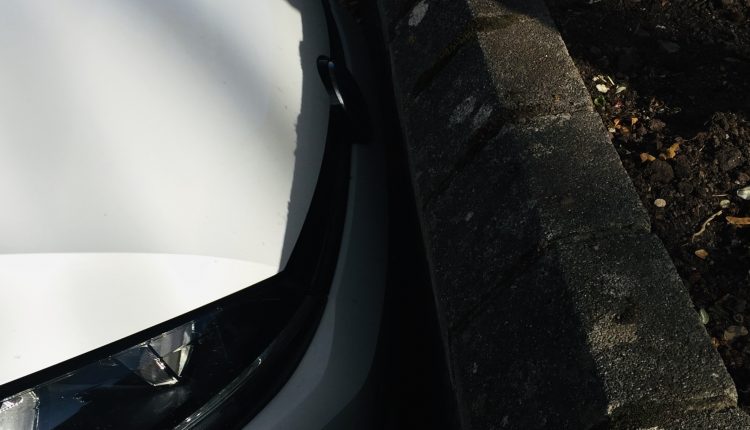
Muttering to himself but so I could hear that he should’ve gone back to move it in the first place and me wondering if I should get my puffer jacket between the car and the wall to soften the impact, O’Grumpy got in, reversed without moving forward, then got out with a stupid grin on his face. I asked how he did that and he said: “It’s a secret.”
Annie Moore (1874-1924)
We walked back to the Heritage Centre for a much needed cup of tea and scones and then went to look for Annie Moore and her brothers now immortalised in bronze by sculptor Jeanne Rynhart. Annie Moore was the first Irish Immigrant to be processed at the new Ellis Island Immigration processing facility at New York Harbour in 1892. She was 18 years (some say 15 years) when she travelled to America with her younger brothers Anthony and Phillip to be reunited with their parents who immigrated four years earlier. For the honour of being the first person through the new facility she was presented with an American $10 gold piece.
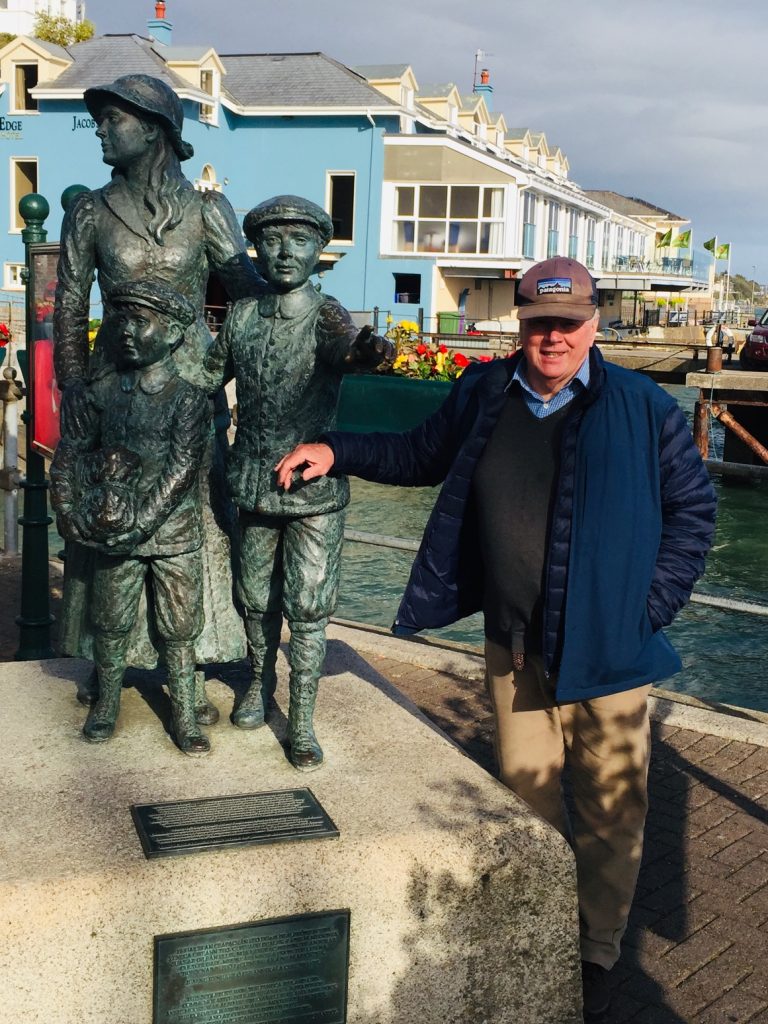
Annie Moore is honoured in Ireland not only in bronze but in the beautiful song ‘Isle of Hope Isle of Tears’ written by Irish Songwriter and Novelist Brendan Graham in 1995 and first released in 1997. Once you hear this song you can’t get the words and music of the chorus out of your head. To me it’s more an anthem than a song for all Irish emigrants.
Isle of hope,
Isle of tears,
Isle of freedom,
Isle of fears.
But it’s not the Isle I left behind.
That Isle of hunger,
Isle of pain,
Isle you’ll never see again.
But the Isle of home is always on your mind.
Even if you are not on an ancestral mission, Cobh is the most beautiful sea-side town to visit and explore.
The O’Leary’s Road Trip Around Ireland – Part Two
During this period of Coronavirus shut/lock down, self-isolation etc. I will write Part Two of the O’Leary’s road trip around Ireland. Part Two will cover Cork, Inchigeelagh and the O’Leary Castle, Killarney, Galway, Donegal, Armagh, Benburb, Kilkeel, Downpatrick, Newgrange and Dublin Airport return.
In the meantime stay healthy and safe everyone and take this time to plan your own special road trip around Ireland. Maybe you could make a loaf of Irish Soda Bread like I did the other day. It didn’t quite come out looking like the photograph that came with the recipe but it was very comforting to eat with lashings of butter and local honey. O’Grumpy loved it.
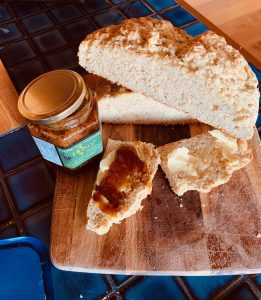
[i] https://en.wikipedia.org/wiki/Thomas_Francis_Meagher
[ii] Or known more formally as ‘The Battle of Ballingarry’
[iii] https://www.ricksteves.com/watch-read-listen/read/articles/the-amazing-life-of-waterfords-favorite-son
[iv] https://en.wikipedia.org/wiki/Thomas_Francis_Meagher
[v] https://en.wikipedia.org/wiki/Thomas_Francis_Meagher
[vi] https://en.wikipedia.org/wiki/Thomas_Francis_Meagher
[vii] https://www.irishtimes.com/news/ireland/irish-news/vikings-settled-near-waterford-50-years-before-city-founded-1.1988116
[viii] https://nickreddan.net/talks/carrick_on_suir.pdf Nick Reddan is President of the Heraldry and Genealogy Society of Canberra (HAGSOC) and works tirelessly uncovering records, and photographing them as he did with the 1799 Carrick-on-Suir census and then transcribing them into a format that can be used by family historians world wide.

Comments are closed.